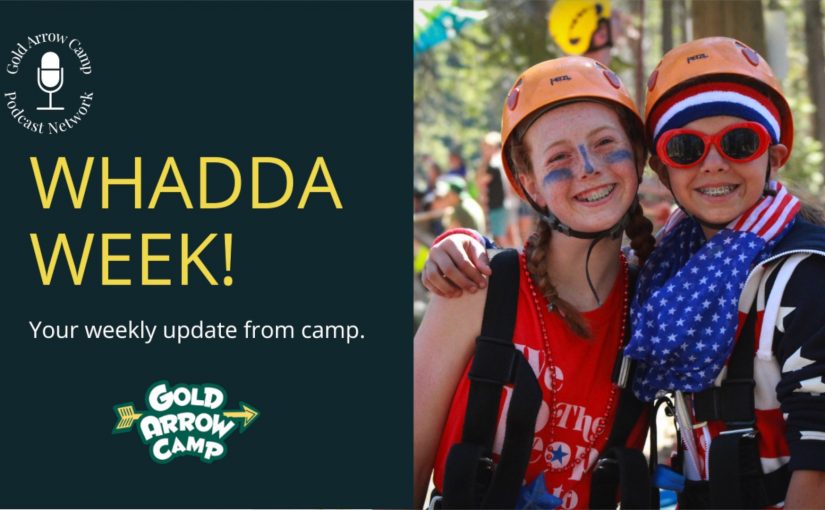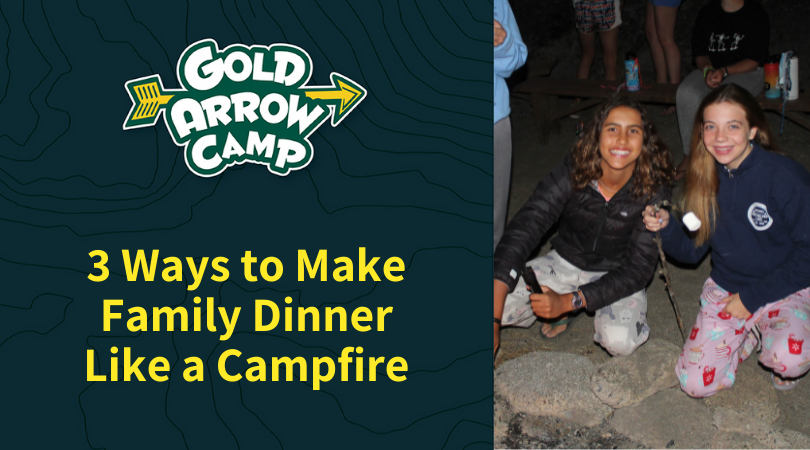
3 Ways To Make Family Dinner Like A Campfire
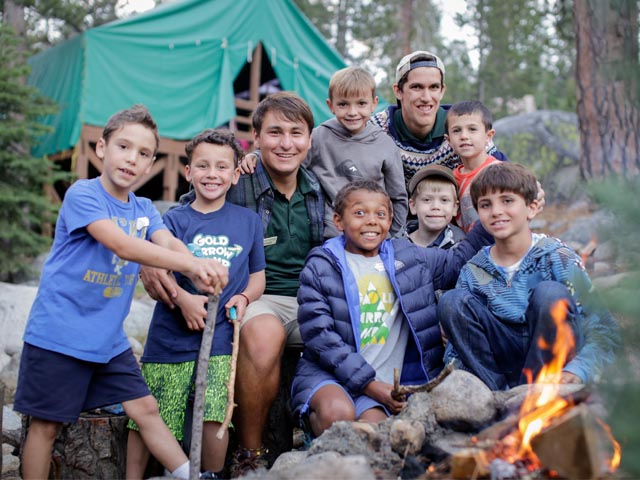
Most of us know the importance of family dinners:
Kids who regularly eat dinner with their families are more emotionally stable, are less likely to abuse drugs and alcohol, get better grades, have fewer depressive symptoms, and are less inclined to obesity or eating disorders.
It’s certainly a compelling list. But what can you do if your family dinner isn’t that great? If people just “eat and run” or don’t really connect? One answer might be turning your dinner table into a campfire pit. Not literally, of course, but group campfires at summer camp offer a great example of fun, engaging activities that have helped make dinners at our house last longer than the ten minutes it takes my boys to shovel down their food.
Here are some ideas:
Sharing highs, lows, and “gratitudes” (I know that’s not a real word, but that’s what we use)
One way we’ve found to get everyone talking and contributing at our dinner table is consistent sharing time. We find out what’s going on in our kids’ lives (and in the lives of unsuspecting visiting friends) and we as parents share what’s going on in ours. For children who are quieter and generally don’t “take the floor” as often, this consistent discussion helps them open up. And for those who don’t naturally focus on the good things, it helps them see the positive in their day.
Around the campfire, it’s an activity called “High & Lows,” or—as it’s now evolved in our family—“Highs, Lows, and Gratitudes.” It’s very simple: Each person has a turn (uninterrupted, with everyone focused on that one person) to share
• their HIGH point of the day,
• their LOW point of the day, and
• their GRATITUDE—what they’re feeling grateful for.
For a twist, we sometimes make rules for sharing: a “high” might be limited to three words, or a “low” might have a one word limit. It creates a fun challenge and makes us think. If we can’t come up with a low, we share another high.
Sometimes, we interrupt, tell long stories, or go off on tangents, but that’s okay. We’re connecting, sharing, and discovering what’s happening in each other’s lives. Our dinners last much longer than ten minutes, and our kids know they won’t be excused until everyone shares.
In The Whole-Brain Child, Daniel Siegel and Tina Payne Bryson write about the importance of getting kids to remember their stories. So, instead of asking “How was your day?” which invariably gets a one-word response, they recommend asking “What was the best part of your day?” and “What was your not-the-best part?” Sounds like a high and low of the day to me!
Question or topic of the night
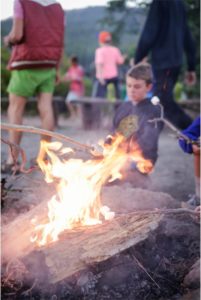 There are so many fun books and table games available, but you can probably just take turns thinking up a fun question for each person to answer, much like counselors do around a campfire. For my birthday a few weeks ago, a friend who knows me well gave me Q & A a day for Kids by Betsy Franco, which has 365 questions (one for each day) to discuss with your kids. We also have used The Enchanted Table (by Memorable Mealtimes) and Table Topics, a box of questions that our kids like taking turns reading.
There are so many fun books and table games available, but you can probably just take turns thinking up a fun question for each person to answer, much like counselors do around a campfire. For my birthday a few weeks ago, a friend who knows me well gave me Q & A a day for Kids by Betsy Franco, which has 365 questions (one for each day) to discuss with your kids. We also have used The Enchanted Table (by Memorable Mealtimes) and Table Topics, a box of questions that our kids like taking turns reading.
Family Meeting (once per week)
At camp, we always start the session with what we call our “First Night Campfire.” The counselor has a specific agenda for the campfire, which includes all the kids getting to know each other, sharing a goal they have for camp, and what guidelines they want to live by during their two-week stay. Families need to do the same kind of checking in with one other, so—once a week—we have a “Family Meeting” during dinner. We have an agenda that’s on a legal pad next to the table, and we take turns being the “chair” of the meeting.
On our agenda:
• What’s going on this week? We talk about the schedule for the coming week (any big projects/assignments due, any events, parents going anywhere)
• Goal for the week: Each person shares a goal for the week (something we want to get done, do better, etc.)
• A value or social skill we want to talk about. These have been focused on social skills for the past year in our house, and we’ve talked about things like looking someone in the eye while meeting them and how to chat with an adult. We’ve also used this printable (“10 Social Manners for Kids” from iMom) for several topics. Lately, it’s been a contest to see who can remember all ten!
We’ll hold fast to our family dinner time as long as we have kids in the house; I know it will be over far too soon. In the whirl of the last four years, our family group of seven has dwindled to the “final four”: me, my husband, and our two youngest. The meals we share are nothing like June Cleaver’s pot roast, and they often involve my awesome husband cooking or picking up something easy to eat or make. It’s rarely a big production, but it’s still really big. When we are gathered around our table eating and talking—with no phones or tablets in sight—it doesn’t matter if we have a home-cooked meal or a Panda bowl; as long as we’re connecting and sharing, it’s the biggest and best part—it’s our HIGH point—of the day.
All we’re missing is the campfire.
Originally published at Sunshine Parenting.
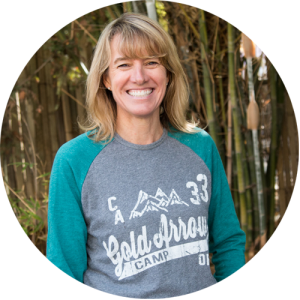
Audrey “Sunshine” Monke, MA, has been the owner of Gold Arrow Camp since 1989 and currently serves as the Chief Visionary Officer. In addition to her vision-casting and mentoring at GAC, Sunshine is an author (Happy Campers: 9 Summer Camp Secrets for Raising Kids Who Become Thriving Adults), podcast host, speaker and coach on the topics of parenting, social skills, and happiness. Find out more at her website, Sunshine Parenting.


